#hugel mounds
Text
Night temperatures have finally gone above freezing, so spring has arrived proper here at last. I've been to didi 3 days in a row, plotting out what I want to build, planting some bulbs and tubers, and using branches to build a raised bed.
I also got approval to build a hugel mound, and I've met several of the other people at the farm plots who've all been very friendly and have praised me for what I've done so far.
Still a long long way to go before it looks good, but now didi doesn't look like a frozen mud field anymore (:
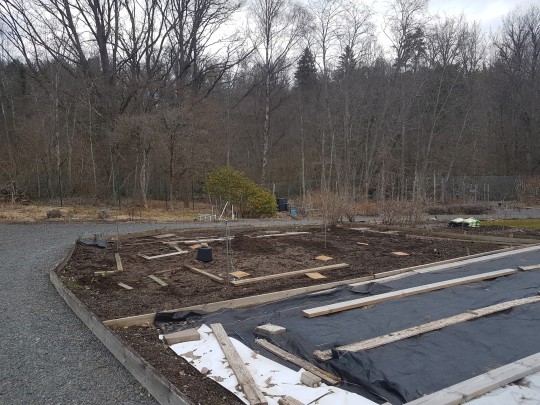
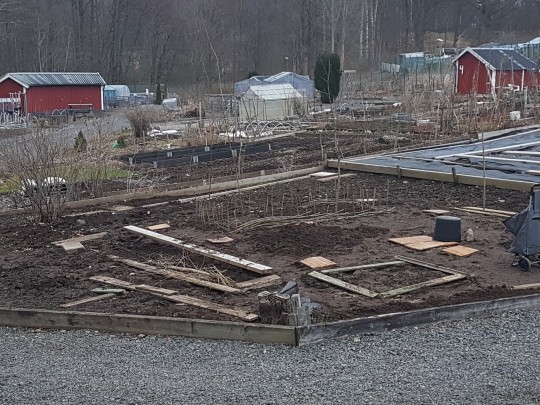
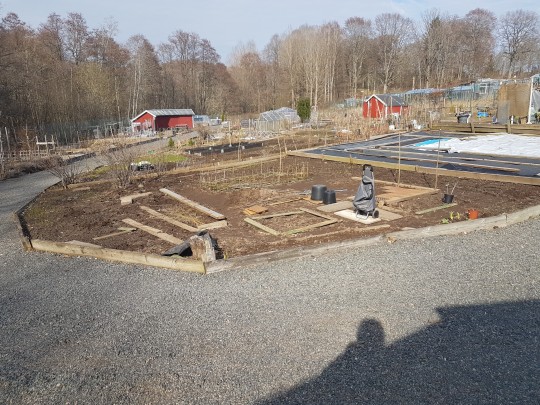
3 notes
·
View notes
Text
Garden Report 23.01.07
So ... Happy New Year!
Was out in the garden new years day feeling rather sad but the day was lovely and I wanted force myself Out. I worry about the ancient fruitless plum tree. There is a section of heartwood exposed and conks are thriving. We always talk about taking it out but might have to be the year to avoid liability. This year has just begun but it has been really difficult and I don’t want it. If nothing else, it has to be topped heavily. The little sapling next to it is budding up to bloom so it needs to happen soon if the weather allows.
This is going to be the year that there we some heavy pruning, so much so that I am thinking we might have to rent a chipper. I like chips and need chips (both wooden for the garden and potato-kind for my belly ;) but that’s another avenue for discussion!).
I think I have tried everything possible under the sun and am reverting back to some older gardening styles. Mind you, this is all just in my head for now. I am wanting to take out the grow boxes but then again I want to raise them up higher. But, for navigation purposes, and not being boxed in (no pun intended) they are going. Most of the wooden box edges have rotted and all building materials are too expensive. I think I am going to go with a perpetual hotbed with French intensive style of growing . I really feel this is going to be the best option for my location after everything I have tried. It will raise the ‘soil’ temperature, keep moisture in the soil on an even keel, keep compost in direct line to consumption of plants and hopefully, less work for higher yields ... and we all like those higher yields/less work ratios! I hate hugell mounds due to the vermin population tunneling and setting up housekeeping so I am hoping that a high hotbed will not have the same problems. Fingers crossed! Time will tell if I can get this project launched.
Garlic that we planted late is popping up just as wonderfully strong ... as if we weren’t late; it don’t care! its super garlic! old variety aka heirloom & robust. I really need to plant more garlic and onions because for some reason they are MIA at the grocers. Need more grow space -- Looking at perhaps taking out a pergola that is next to the area of the summer house. I hope that opens up more space for container growing if I can beat down the monster kiwi who came back From The Dead With Vengeance! The bamboo and kiwi are now courting cousins of the third kind and a bane to my sense of permaculture garden dwellers. I can yell Not In My Garden but obviously, yes, in my garden, in spades [cue theme song mash up Who Ya Gonna Call from Ghost Busters and Bad Boys from Cops].
Hens, I love my hens. For Christmas I got a ceramic art tile that says “I get by with a little help from my hens”. We jest that they are my therapy chickens but you know, its not far from the truth. Maybe I can get just a few more (chicks) and slowly integrate ... I’ve done that before but its like some of the ‘blended family’, they tolerate each other and pretend to play well with each other while being watched BUT technically have two micro flocks.
The Worm friends, I confess, I have neglected. I just have not been mobile enough to be fussing over them. They are probably happier that I am not disturbing them. They are hardy stock and don’t complain (unlike my vocal chickens!). When/if I do my hot mounds/hot beds I will introduce part of the population to those situations. I had divided my vermiculture holdings into two boxes so I will probably take the older box for the beds since that box will probably be composted the most (?) idk. Have to wait and assess.
I have my plastic ammo can of seeds that I keep my newest seeds in. I have my older seeds in a shoe box and need to Do-A-Dump garden which is kind of fun. I mix all my old seeds and broadcast sow into a single bed. If it grows, huzzah! If it don’t, it won’t and just nestles itself into the compost cycle of things. I have to do this every couple of years because saving, sharing and purchasing happens more than what I can use for my small patch at one time so it all sort of just gathers up and accumulates to a point of action is necessary ... I could make seed bombs but my experience it, they don’t do well. Cute idea, big on the feel good aspect but really not best situation for the germinating seeds. So we do the Do-A-Dump so they have a better chance of surviving.
So this is the update of the garden doings -- most of it just plans while we wait through the Winter months. Hope everyone is planning and dreaming of gardening, both big and small.
#catholic gardener#gardening#garden#2023#winter#permaculture#vermiculture#hens#seeds#new plans#old ideas#seed bombs#hotbeds#hot beds#compost#worm compost#pruning#trees
4 notes
·
View notes
Text
Moving logs makes soil life (spent shiitake logs to rich hugel mounds)
http://www.edibleacres.org
https://www.youtube.com/watch?v=dCz1NdR-Rm0&ab_channel=EdibleAcres – 2014 video showing a pretty intense flush from this very yard. Pretty neat to see them in their hay day 🙂
https://www.youtube.com/channel/edibleacres/join – Join as an Edible Acres member for access to members live Question and Answer sessions and to support our work!
https://www.paypal.me/edibleacres…
View On WordPress
0 notes
Text


With silver bells and cockleshells...
Tomatoes are finally (! 😰) turning red. These are big, beautiful fruits and there are a lot... Gonna have a late but yummy harvest, I hope.
I wanna rub a crayon over paper on all the cantaloupes!
#pseu plants... supplants?#this post is supplanting fanfic and queue stuff 😂#gardening#thinking hard about next year#i want to fence in an area to protect things better from bunnies and chipmunks#try some of that beautiful glass corn in a three sisters planting#hugel mounds? huy not!
13 notes
·
View notes
Text
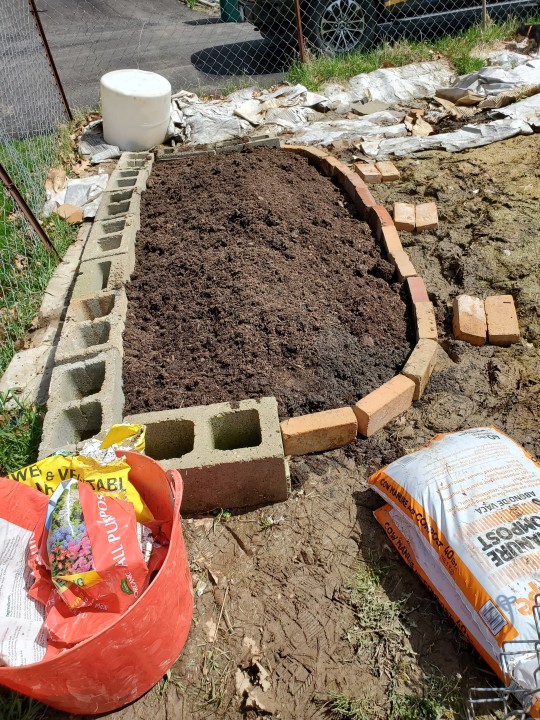
My hugel bed ended up not much of a mound after winter but it's still my first a raised bed! This area was a big depression that filled with water every time it rained before.
48 notes
·
View notes
Text
The hugel mound giveth, the hugel mound taketh.
I was throwing the ball with my dog this evening and she’s incredibly ball driven. She has complete disregard for her body when it comes to catching her ball. Well today I threw the ball, it ricocheted off an old tree root and ended up over by my hugel beds. My dog, at full speed, rams into one of the mounds and rips half of her chest skin open . There’s a giant piece of skin dangling from under her. Long story short, the emergency vet said that she needed a wet bandage due to how dirty the wound was. That will cost between 1,000 and 1,600. Then tomorrow she’ll get to see the surgeon to sew her back together. Who knows what that’s going to cost. Anyway, the hugel mound will provide you with a great bounty, but it’ll cost ya
19 notes
·
View notes
Photo

Derfflinger Hügel
Derfflinger Hügel is a prehistoric and early historical burial mound near Kalbsrieth, Thuringia, Germany.
Read more at: https://paganplaces.com/places/derfflinger-hugel/
4 notes
·
View notes
Text
i planted out almost all of my seedlings yesterday... the garden is getting full of tiny little plants! there’s just a few tomatillo and eggplant seedlings that are still small so i’m keeping them in to get 2-3 more leaves before transplanting. i started the pole beans & zuccs to go with the corn and some carrots and lavender. i think sunday we’ll go to the garden store and get a bit more dirt and some mulch so these guys don’t dry out... then i can plant the carrots & the hugel mound (with cucumbers and pinto beans) & the potted potatoes.
3 notes
·
View notes
Photo

My site is all of the yard behind my house. When we chose our home in 2003 at the Keystone part of town, I was thrilled to be surrounded by so much mature green space. My backyard only had grass and volunteer vegetation, and since the area is multi-tierred, it was exhausting and time consuming just to keep it mowed. Throughout the years I have incrementally added edibles, perrenial plants, flowers, and allowed some walnut trees to establish. Now I enjoy seeing the yard develop into a lush garden that many creatures also enjoy. Mother nature is the principal architect for my site. She enabled birds and squirrels to plant many varies. I do a bit of editing from time to time. My site has become a habitat for many.
Transforming my yard into a small food forest has been a rewarding learning experience. My contribution to the land is driven both by reusing organic waste and zero carbon emissions, and through healthy eating. In any given year you can find foods such as raspberries, strawberries, serviceberries, kale, tomatoes, chili peppers, corn, beans, squash, onions, oregano, sage, dandelions, and purslane. When I first discovered permaculture themes in gardening, I learned how to sequester carbon by avoiding to till the soil, but instead build the soil by layering select garden refuse from the previous season with leaves and our generated compost. I don’t toss out the grass. After I mow the tall grass, I harvest and dry it for mulch. Instead of taking “yard waste” like twigs, branches and weeds, I either chop and drop or bury the wood and build mounds structures know as hugels. Hugels promote myco-culture, water retention, and habitats for small critters. All of these components are processes that are interdependent. I find great joy in the collaboration with these plants and animals. It is a mutually beneficial relationships we have.
This practice of collaboration in healthy land stewardship has me thinking about extending those principles into community engagement. Namely, to consider the valuation of carbon-based materials like “yard waste” and how to sequester them. In regards to growing food, I am fascinated with combining corn, beans, chilis, and tomatoes to pay homage to my Hispanic / Latino heritage with prepared Mexican cuisine. I love to grow popcorn also. My site provides for the corn yields and sunny space to install my portable solar panels for zero carbon electricity. I am curious to see how much popcorn I can prepare with solar power. Once I begin playing around with cooking food generated from my portable electricity, I will take it out to one of the other sites where I practice in Benson and share food fellowship.
2 notes
·
View notes
Video
Coyote 01. Don’t know why the camera came on so late and missed the beginning. Hugel-mound right behind it. I want to get better footage of the backyard wild-life.
1 note
·
View note
Text
Garden Report 20.03.28
I spent the day digging. And digging. And sweating in the rain.
Sometimes when gardening, you hear about these great things. You put them into practice and then find they are a head ache, a heart ache and a nuisance. Such was today.
When we moved into this place I tried instilling some of the same garden practices that I had in the mountains. There was more than enough room to carve out a niche garden out in the woods. BUT In an urban setting, the same practices had disastrous results. Not in a Titanic sense; no one died but believing the touted ‘greatness’ was the first step in that ‘sinking ship’ … ladies and gentlemen, may I present the hugel mound. Before you draw your ire at me, let me say good for you if it worked in your setting.
In my urban setting we had a huge fir that the neighbor offered to take down (disregard he had ulterior motive) and so it came down. With that much wood, we got rid of what we could to people needing/wanting firewood but still needing disposal of the other brush, it was cost prohibitive and what to do? Hugels seem to be the logical solution. Little did I know (being new to the neighborhood) that there were problems just lurking on the other side of the fence and beyond.
Hugel mounds are the perfect nesting grounds for urban rats. The neighbors never shut their rubbish bins (if they can get it in the bin) or leave it bagged in the gutter. The maze of fence rows become super highways for rodents. Congrats! You have just created a wonderful habitat for vermin. Look at it as a B&B. And rats aren’t just content with eating garbage scraps but also your vegetables and fruits. Rats also don’t care where they defecate: grow box, fence, pathways. Or what they chew on. Or where they die. Needless to say, in less than one season, I obliterated the mounds.
Today I was digging in an effort to move the little sickly Asian pear tree and dealing with the underground portion of the hugel. I have very sandy soil so much of it had not rotted away, not to mention the root system of the big fir that was cut down years ago. Hugels are great in the right place and time but what works for another, may be more work, more head ache and a heart ache for you. It is a wild world out there gardening. Knowledge is power. Learn from your mistakes and if you are more fortunate, learn first from another’s mistakes.
#catholic gardener#gardening#hugel mounds#hugelkultur#rodents#rats#learn from other's mistakes#its not a one size fits all in gardening#location location location#location is very important#know your neighbors#pest#digging in the rain#know who and what is in your garden
1 note
·
View note
Text
Hugel mounds - Strategy for Clearing Woodland and Making 'Future' Gardens
submitted by /u/edibleacres
[link] [comments]
1 note
·
View note
Text
What Is the Best Way to Fill Raised Garden Beds with Soil?
Once you have assembled your Vego organic gardening raised beds, the next task is filling the raised garden beds before planting. One of the most common questions we get from new gardeners is how to fill a new raised bed and still save money. There are many different methods out there that work well! From our experience, the Hugelkultur method is the easiest and most cost-efficient method to use.
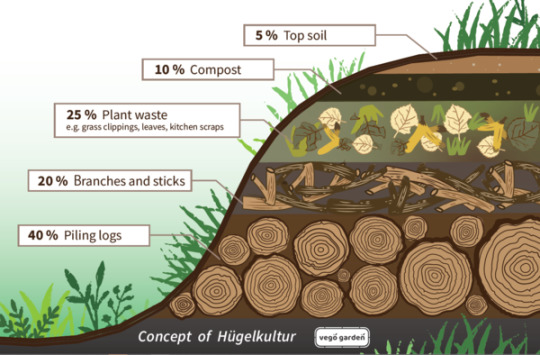
The Hugelkultur Method to Fill Raised Garden Beds
To create a bountiful garden bed, organic matter such as rotted hay, plant waste, and compost is added to the soil. Wood debris decomposes slowly, making it a stable source of organic matter. The optimal kind of wood used is one that is starting to rot, which can be obtained from branches cut from a dead tree or logs from an abandoned wood pile.
Hulgelkultur Method Advantages
The Hugelkultur method has many advantages and has been proven to work well for gardeners all around the world. If you are seeking to cut down on costs, or looking for a sustainable gardening technique, then this method is for you. The vertical nature of the mound helps maximize surface area, which is useful in compacted, urban areas. Therefore, it is a method that is suitable for farmers, gardeners, and homeowners.

You can build the garden in a sunny or shady location. Hugel beds are very versatile and can support many types of plants, including vegetables, herbs, and fruits. Make sure to match the plant to the appropriate growing conditions. Vegetables grow best when exposed to full sun.
Visit Us for More Information:- https://vegogarden.com/blogs/academy/how-to-fill-raised-garden-beds-and-save-money
#metal raised garden bed diy#galvanized raised garden bed#raised garden bed for plants#garden bed shop in Houston#tall herb garden bed near me#buy modular steel garden bed
0 notes
Text


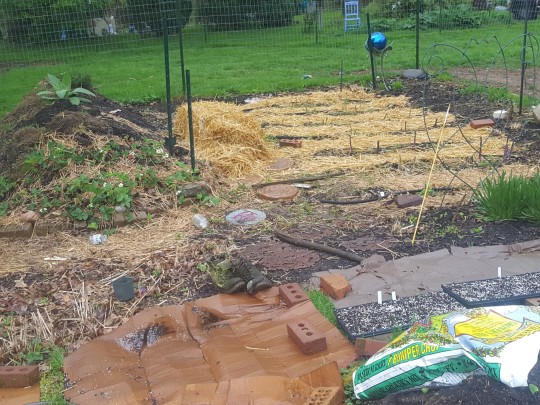
My parents new expanded garden ft. two hugel mounds. First mound is partially strawberries, then the asparagus patch is next to that. Second mound still needs dirt added and buckets are for potatoes. We had a bunch of flats freeze at the greenhouse early on this year so have been using them to plant things and fill pots with dirt. Yesterday I seeded a flat of common milkweed, flat of tall zinnias, half a flat of swallowtail fennel and half of showy milkweed.
65 notes
·
View notes
Text
Tales of the dreaded neighbor
As some of you know I've been on a hugelkultur kick lately. I've used a ton of leaves, twigs, small branches, compost, coffee grounds, dirt and grass clippings. Well, some of you familiar with composting know that once grass gets wet/starts breaking down it tends to smell. To me, definitely a manure smell. However, I don't mind the smell at all since it tends to dissipate within a day or two once some air gets back into it. Anyway, here's a message I received yesterday,
"Hi! Question for you how long will the compost piles be there on the edge? It's starting to smell pretty bad and it's not a pretty site. 😬 sorry."
Now I'm not one to get mad at uneducated people. And I mean uneducated in the topic of growing food. Uneducated in alternative ways to grow food, more importantly. Compost, when done correctly, shouldn't smell at all. And my compost piles on the other side of the yard do not. This is a circumstance where I used grass that had sat in a pile overnight instead of going directly on to the hugelkultur as it usually does. I explained that the smell is not a normal byproduct of a hugel bed and should be gone in a few days.
As far as being unsightly, completely temporary. My original hugelkultur started off around 4-5 feet tall. After a year it's now down to about 2½ - 3 feet. I also explained to her that yes, they're ugly mounds in my yard...right now. But they'll break down and in the future will be covered in plants. Plants which her and her family will directly benefit from. Also, they're on my fucking property so piss off haha.
I like my neighbors, a lot. Younger couple, young kids who come over to play with my kids almost daily. We drink beers together, go to parties at each other's house, exchange Christmas/birthday gifts and chat whenever we see one another. They think we're nuts here with how we grow our food. It's a VERY confusing thing to pretty much anyone in my neighborhood. Everyone calls us "The Hippies" around here.
My neighbor is also the kind of person who won't eat a locally raised chicken egg because it has dirt on it. She thinks farming is gross. Doesn't like to get dirty, doesn't like to smell anything a tad off-putting. Perfect house in a perfect neighborhood with a perfect yard. Perfection is in the eye of the beholder. My hugel mounds are perfection. I built them. Every stick, every coffee ground, every blade of grass. And when these things are filled with flowers and food they'll be even more perfect. Perfection takes time.
The moral of the story is to try and educate people about what you're doing. I would usually look at that message and get annoyed by it. But because I know the end result and she doesn't, I'm not worried. This is a situation where "wait and see" is appropriate. Anyway, can't wait to see the messages I get when the ducks come in the spring 🤭🙃🙃
12 notes
·
View notes
Photo

Raised Bed Ideas (VegoGarden)
Once you have assembled your Vego organic gardening raised beds, the next task is filling the raised garden beds before planting. One of the most common questions we get from new gardeners is how to fill a new raised bed and still save money. There are many different methods out there that work well! From our experience, the Hugelkultur method is the easiest and most cost-efficient method to use. Summary Hugelkultur is the process of layering organic garden waste inside the raised garden bed, before adding soil to save on costs, in addition to attracting and preserving moisture. Of German origin, hugelkultur translates to “mound or hill culture.” It is especially applicable in areas where soil retention and drainage are poor, which is typical of soils found in urban areas. The materials used include large rotting logs, sticks and other debris that are layered with grass clippings, coffee grounds, compost, and other organic matter. As the material breaks down, it creates a flourishing environment for beneficial fungi and microbes that mimics the natural landscape of a forest. There are many advantages to the Hugelkultur method, including soil quality improvement, minimal maintenance, and water retention. The Hugelkultur Method to Fill Raised Garden Bed Soil To create a bountiful garden bed, organic matter such as rotted hay, plant waste, and compost is added to the soil. Wood debris decomposes slowly, making it a stable source of organic matter. The optimal kind of wood used is one that is starting to rot, which can be obtained from branches cut from a dead tree or logs from an abandoned wood pile. This organic matter will decompose over time, and plant roots will travel deeper into the raised garden bed soil to obtain the nutrition. It will also work as a big sponge, and retain water to maintain an ideal moisture level. In the Hugelkultur method, the large pieces are laid at the bottom as they will take the longest time to decompose. In the picture above, the piling logs may take up to 5 years before the base sponge breaks down into rich, wonderful raised garden bed soil. The smaller pieces are placed on top of the larger pieces to fill space, such as branches and sticks, and then grass clippings, leaves and kitchen scraps. Compost and topsoil are on the top two layers for your raised garden bed so you can start planting as the organic matter beneath decomposes. Some Considerations When Using This Method Pests: Something to be aware of are termites, especially if you live in a wooded area with a high termite distribution, which can be attracted to the large amount of buried wood. However, most termites tend to live in dead trees that are still standing, rather than buried logs found in hugel beds. Garlic can be grown for pest control. Make sure to be vigilant against pests such as slugs, snails, and pill bugs. You can use organic pest control such as beer traps if slugs become a problem. Various Hugelkultur Methods: The classic method requires you to dig a deep trench around 2 meters and fill it with large logs, adding progressively more logs until it becomes mound-shaped. Most gardeners dig a shallower trench that is about 1 meter. Vego raised garden beds provide a convenient alternative that only requires you to fill the container on the ground with the appropriate contents. They provide structural integrity through an enclosed terrain that is easy to manage and will last for many years, making it the perfect framework. That way, you don’t have to spend time digging a trench or placing a fence around it, which can be burdensome and labor intensive. Additionally, it is more aesthetically appealing than just a mound on the ground, which is unsightly to some. Wood Type: The right type of wood is important to consider. Hardwoods are recommended as they break down more slowly and hold water longer. However, softwoods are also acceptable. The woods that work best include birch, alder, maple, cottonwood, willow and oak. Avoid allelopathic trees like black walnut, red oak, and sycamore, as they contain chemicals that inhibit plant growth, as well as rot resistant trees like black cherry and black locust. Preparation: Be sure to add a fresh layer of compost on top prior to planting. The combined layers of organic material above the wood should be as deep as the wood base. This means a 30
0 notes